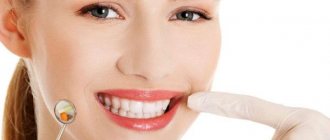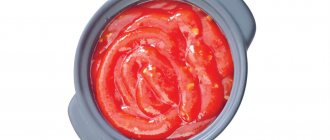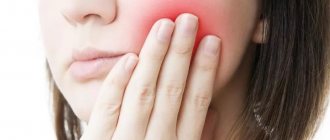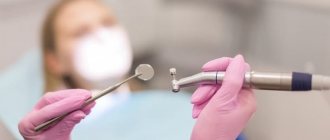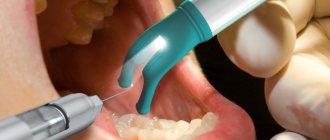At the Ameldental dental clinic, dental fillings are performed using modern materials, therefore, the filling will last a long time and will not cause discomfort or unpleasant sensations. However, if the dentist's recommendations are not followed, the filling may become unusable and even fall out. In addition, patients often have questions, for example, why does a tooth hurt after filling, when can you eat after filling, and others.
This article provides answers to common questions and recommendations from clinic specialists.
Rules for caring for teeth after filling
Types of fillings and care features
In the first days after filling
If the filling is temporary
Why does a tooth hurt after installing a filling?
Why is a preventive examination necessary?
A filling cannot replace tooth enamel. No matter how similar it may be in appearance, in terms of its characteristics and properties the filling is significantly inferior to native enamel. First of all, because it has a service life. A filling can protect a tooth for about 3 to 5 years, then it will have to be replaced. With good care and proper installation, the filling can last longer than expected. We'll tell you how to properly care for your teeth after filling, so you don't have to run to the dentist ahead of time.
Sealing
This moment is very important. Today, two main methods are used to fill dental canals: introducing dense cone-shaped gutta-percha pins into the canal (the so-called lateral condensation) and filling a fragment of the dental canal with a heated mass from the same gutta-percha, followed by the introduction of cone-shaped pins (the so-called vertical condensation). Both of them are very effective and allow you to reliably “seal” all additional branches of the main channel.
All filling materials come in two types. The first is sealers, also known as endosealants, that fill the root canal. The second is the so-called fillers, which fill the lumen of the dental canal. Sealers are divided into pastes based on epoxy resins, calcium hydroxide and zinc oxide, as well as cements.
Upon completion of dental treatment while asleep or under anesthesia, the doctor sends the patient for an x-ray - it is important to find out whether the root canals are completely filled with endodontic filling material. If everything went well and the canal is in order, you can proceed to the final part of the process - filling the inlet.
Types of fillings and care features
Different fillings have their own characteristics in terms of wearing time, hardening, etc. For example, light fillings harden under the influence of a halogen lamp in a matter of seconds, so you can eat or drink water almost immediately after the procedure. However, you should not remove all restrictions: complete hardening of the filling occurs in two days. Composite fillings are very sensitive to alcohol at first, so you should avoid alcohol and alcohol-containing rinses, as the filling may soften.
After treatment, we recommend that you check with your dentist about the type of filling he placed and after what time you can eat.
Procedure immediately after removal
Tooth extraction is accompanied by a number of activities performed before and after the procedure:
- Do not keep the cotton swab applied by the doctor for longer than 15 minutes. It must be carefully removed so as not to disturb the blood clot. If this is done too late, the wound may become infected, as this is a favorable environment for bacteria to multiply.
- To reduce swelling and relieve pain, apply cold to the cheek, such as ice or frozen food wrapped in a towel. Keep it on your cheek for 5 minutes with constant breaks. Usually 3-5 approaches are enough, but for this, cold water must be applied in the first 4 hours after the removal procedure.
- Sometimes the dentist uses a hemostatic sponge if the bleeding does not stop for a long time. This often happens after wisdom tooth removal. This sponge has an adsorbent, antiseptic, analgesic effect and, in addition, contains the drug alvostasis. It is placed in the hole, and the patient is allowed to perform superficial application only if necessary.
- For severe pain, it is recommended to take painkillers like analgin, tempalgin, spasmalgon, ketanov, ibuprofen, etc. But it is better to consult a dentist about this, since all of the listed medications have a number of contraindications.
- After tooth extraction, you should not drink or eat for 2-4 hours. But it all depends on the complexity of the procedure. So, if several teeth were removed at once or we are talking about a case with suppuration, inflammation or a full-fledged operation with sutures, then this period may be longer. If you really want to drink, you can do this through a straw and in very small sips; optimally, water at room temperature. Under no circumstances should you drink drinks containing alcohol, as it can cause bleeding due to its diluting effect.
- You should not smoke on the day you had a tooth removed, as nicotine has an irritating effect on the tissues of the oral cavity. In addition, each puff involves the formation of a vacuum effect, which poses the risk of dislodging a blood clot and causing a dry socket. If this happens, there is a good chance that you will need medication.
In the first days after filling
The filling easily absorbs coloring pigments, so you should adjust your diet in the first week.
- Avoid coloring foods (coffee, tea, bright berries, beets, red wine, foods with food dyes).
- Avoid sticky and hard foods (nuts, toffee, kozinak). Hard products can deform the surface of the filling, while viscous products, due to their sticky consistency, contribute to the development of caries.
- Food should not be too hot or cold. The seal must be properly secured. Temperature changes, on the contrary, will interfere with a tight seal.
- It is better to chew on the opposite side.
What about smoking?
It is not advisable to smoke immediately after the procedure, since tobacco smoke affects the adhesion of the filling material to the tooth tissue. In addition, smoking can cause the filling to change color and be very different from the enamel.
Stages of cleaning dental canals
To properly clean the dental canals, the dentist must carry out the following necessary manipulations (step by step):
- Applying a protective lining to the area adjacent to the affected tooth. First, injection anesthesia is performed (or dental treatment is offered during sleep), and then the doctor places a protective pad around the tooth in the form of a thin sheet of rubber. Since the main goal pursued in the treatment of affected dental canals is to cleanse them of bacteria from the inside, the protective overlay reliably protects the tooth from saliva. After all, saliva contains many bacteria, and if the affected tooth is not isolated, then new colonies of bacteria will again rush into the freshly cleaned dental canals.
- Providing access to the dental nerve . This is why the doctor drills a hole in the tooth. There is no other way to reach the area in need of cleansing. Therefore, the doctor creates this access himself in order to begin treatment as soon as possible. For this, a well-known dental bur is used. With its help, the specialist enters the pulp chamber of the diseased tooth through a tiny hole.
- Cleaning the cavity of a diseased tooth . To clean the inner surface of the tooth cavity, the dentist uses special files—the so-called tools that look like long needles. In fact, these are rather micropiles that perform a similar function. The doctor performs manipulations with the canals, operating with several files of different diameters - from smaller to larger. During the cleaning process, he simultaneously rinses the tooth cavity in order to thoroughly clean the tooth canal along its entire length.
- Closing the dental canal with filling material.
If the filling is temporary
A temporary filling is usually placed for 1 to 2 weeks, so it is not as durable as a permanent one. You don’t need to be afraid to brush your teeth, but you shouldn’t put too much pressure on the tooth while brushing. It is also recommended to avoid chewy foods and chew on the opposite side.
Hygiene after tooth filling
In general, oral care after a filling is installed is no different from usual.
| Brush your teeth twice a day for 2 – 3 minutes. It is better to use a brush with soft bristles that does not scratch the enamel and the surface of the filling. |
| Try not to brush your teeth with abrasive whitening toothpastes. |
| As an addition to daily care, we recommend using an irrigator. It cleans hard-to-reach places from food debris without harming enamel, gums and fillings. |
What does the canal consist of and why should you clean it?
The inside of the dental canal is filled with pulp. It is a soft tissue penetrated by nerve fibers. In addition, it contains blood and lymphatic vessels and connective tissue. When an inflammatory process occurs in the pulp, the soft tissues inside the canal are also affected. Sooner or later it comes to such an extremely unpleasant thing as their necrotization.
The cause of inflammation can be caries or pulpitis. Therefore, in order to relieve the patient of acute pain and prevent tooth extraction, it is necessary to clean the dental canals of dead tissue.
The capabilities of modern dentistry in the vast majority of cases make it possible to completely cure and save the affected tooth, while just 10 years ago such inflammation invariably led to surgical removal of teeth.
Important! A disease that has become chronic may well be asymptomatic.
Consequences of anesthesia
Of course, most patients are faced with the fact that after visiting a doctor and undergoing even a simple operation with the need to administer an anesthetic, part of the face remains “frozen” for some period of time after the procedure is completed. In this situation, there is a risk of accidentally biting hard or injuring your gum or lip and not even feeling anything.
This problem is quite common in the youngest patients of clinics. While the anesthesia has not worn off, they may or may not intentionally bite or pinch themselves. As a rule, this leads to minor injuries, scratches, and sometimes to more serious consequences. In this case, parents may need time to completely heal minor wounds, especially if they are on the inside of the cheek.
Adults, at the time of gradual cessation of the effect of “freezing,” often suffer from an unpleasant feeling of discomfort, nausea, dizziness and headaches.
What not to do?
The postoperative period after tooth extraction is 5-7 days. At this time, you need to be attentive to your health, measure your temperature, and monitor for bleeding. If the pain persists for more than 2 days or intensifies (or becomes throbbing), you should contact your dentist.
Over time, healthy tissue forms at the site of the blood clot, but this can be disrupted if the area is not properly cared for. After tooth extraction surgery it is not recommended to:
- Taking anticoagulants because they thin the blood.
- Bathing in a hot bath, visiting a bathhouse and sauna. Sudden changes in temperature can be harmful, as they cause spasms or dilate the lumen of blood vessels. As a result, the pain will intensify and bleeding may resume.
- Rinsing the mouth.
- Drinking alcoholic beverages.
- Smoking.
- Spitting, as this may dislodge the blood clot.
- Treatment of other teeth, including caries, earlier than a week after extraction. As a result, infection can occur, since carious teeth contain many bacteria.
- Strenuous physical activity, especially heavy lifting and bending. This is one of the reasons for increased blood pressure, which serves as a provoking factor for the opening of bleeding.
- Chewing food on the “sick” side of the dentition.
- Active facial expressions. If there are sutures in the oral cavity, they can break and even come apart.
What happens if you break the rule of the white diet?
Nothing catastrophic, but the effect of teeth whitening will no longer be the most ideal. Firstly, a thin film of pigment deposits will do its job - the color will darken. Secondly, if the diet requirements are violated, the very shine and sparkle of the enamel will disappear, for which many patients love whitening so much. Thirdly, the patient himself will see the difference in his teeth, and he will be offended that, for the sake of a moment of weakness or inattention, he ruined the aesthetics of a perfect smile. There is also a risk of tooth decay or inflammatory gum disease.
What exactly is not recommended to eat on a white diet? Stop list of products
The white diet excludes the following foods from the diet:
- black and green tea. By the way, it is green tea that causes plaque to form on teeth extremely quickly. This product should also be excluded from the white diet so that your teeth do not darken after whitening;
- bright sauces: tomato, soy, adjika, ketchup, etc.;
- coffee, cocoa are obvious stop drinks of a transparent diet;
- colored fruits: plums, dark grapes, red apples;
- fruit and vegetable juices, compote, fruit drink;
- chocolate, lollipops, dragees;
- citrus;
- jam;
- egg yolk;
- red wine.
The effect of alcohol on a treated tooth
Some people think that alcohol after dental treatment additionally disinfects the oral cavity, but doctors say the opposite. After dental treatment, especially after treatment of pulpitis or periodontitis, the body needs rest. Not only the daily routine should be gentle, but also the diet, so at this time it is better to give up alcoholic beverages.
Let's tell you why.
- Alcohol can cause bleeding because alcohol dilates blood vessels and increases blood pressure.
- When drinking alcohol, the oral mucosa is irritated, the healing process slows down, and the risk of inflammation increases.
- Alcohol increases the load on the cardiovascular system and liver.
- Alcoholic drinks in combination with an anesthetic can cause headache, weakness, and convulsions.
Despite the fact that the effect of anesthesia wears off on average after two hours, the breakdown products continue to remain in the body for several more days.
1. A gauze swab on the hole. When can it be taken out?
As a rule, the doctor does not immediately release the patient after removal, but asks him to wait for 15-20 minutes within the clinic to then examine and make sure that everything is in order with blood clotting and the tampon can be removed without fear. In rare cases, keeping the tampon in your mouth may take 30-40 minutes, usually 10-20 minutes. There is no need to keep it longer and it is even dangerous, because bacteria accumulate on it and there is a possibility of infection. There are exceptions, when the wound continues to bleed a little, then the old tampon is replaced with a new sterile one and kept for some time.
For some time, saliva may still be pinkish due to staining with secreted ichor, this should not be alarming, this situation can be distinguished from bleeding. At this moment, saliva can be easily swallowed; there is no need to accumulate it in the mouth.
Top 8 healthy foods for gums
Bleeding, weak and pathologically altered gums will not be able to support healthy teeth. That is why, first of all, you should select useful substances for healthy gums, and then strengthen your teeth.
In numerous illustrations showing healthy foods for teeth in pictures , you can see what foods should be included in the diet to maintain healthy gums:
- Pumpkin, carrots, and apples, due to their structure and chemical composition, ideally keep gums in order.
- Dairy products strengthen the circulatory system.
- Leafy vegetables contain a large amount of vitamins.
- Sea fish is full of multivitamins and healthy fats.
- Garden and forest berries are a real chest of vitamins.
Eating these foods daily will lead to healthy teeth. They are oversaturated with vitamin complexes and other useful components, adjust metabolic processes in tissues and clean teeth from plaque. As a result, the gums become strong and the teeth become healthy.


